SaveNetRadio
How fast do radio waves travel.
We use radio waves from television and cellular service to navigation and air traffic control. Still, we don’t often stop appreciating them and just how crazy fast they really are. So, how fast do radio waves travel anyway?
Topics Covered - Index

How Fast Do Radio Waves Travel Through Space?
How long does it take for a radio signal to reach pluto, how long does it take for a radio message to travel from earth to the moon and back, how long does it take for radio waves to travel to the sun, how fast are radio waves compared to other types, can we detect radio waves from an alien civilization, so really, how fast do radio waves travel.
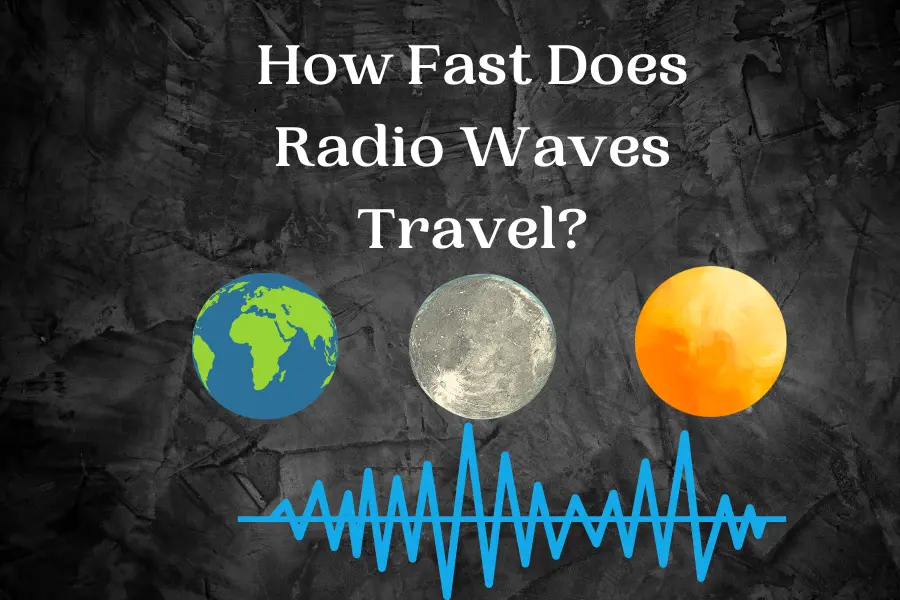
Unimpeded, radio waves travel at the speed of light because they are part of the electromagnetic spectrum. In terms of miles, radio waves travel at approximately 186,000 miles per second or 300,000,000 meters per second.
If you’re a science lover or just curious about the technology that makes your life easier, you’ve come to the right place. In the sections below, we will break down how fast radio waves travel, whether they’re in space or here on earth.
We’ll also answer interesting questions like how long it takes for radio waves to reach the moon or pluto. So let’s just dive right in!
There is a common misconception that radio waves travel slower through space than they do through the air. The truth is that radio waves travel at the speed of light, even in space. It might seem like it’s taking them longer because space is so vast that even light and radio waves take considerable time to make their way across it.
There are galaxies we will never be able to see because they are so far away from us that the speed of light waves can’t keep up with the expansion of the universe. The same, of course, would be true of any radio waves coming from a civilization outside the observable universe.
To get some perspective on how vast the distances are that radio waves travel through space , let’s see how long it takes for them to travel from our friendly rock Earth to the dwarf planet Pluto.
Radio waves take about four and a half hours to travel from Earth to Pluto. That’s because the waves must travel about three billion miles before reaching their destination.
Now let’s look at an object that’s a little closer. Our moon . The question is, how long does it take for a radio message to travel from the earth to the moon and back?
Radio waves can travel to the moon and back at an average of about 2.56 seconds. Therefore if you sent radio waves on a journey to the moon and back, it would be the blink of an eye before they return. They can make it quickly because the distance from Earth to the moon is only about 238,855 miles. When compared to the 92.5 million miles between Earth and the Sun, that’s nothing.
You may be wondering, what about the sun then? How long does it take for radio waves to travel from the earth to the sun?
Radio waves take eight minutes to make their way from the earth to the sun.
That may seem like a short period, but remember, these waves are traveling at the speed of light. This just goes to show how unbelievably big our solar system is, let alone the whole universe.
To really get an idea of just how incredibly fast radio waves to travel, you just need to compare them to other kinds of waves like sound waves and light waves.
Below we’ve listed two other types of waves and their speed compared to radio waves:
- Sound waves : Radio waves are a form of electromagnetic wave. Sound waves on the other hand, are a form of mechanical waves. Mechanical waves are not nearly as fast as electromagnetic waves because they are not made of light. Therefore sound waves can only travel 1,100 feet per second. That’s a far cry from the speed of light.
- Light waves : Like radio waves, light waves are also a form of electromagnetic wave. As such, light waves also travel at the speed of light. The main difference between light waves and radio waves is their frequency.
The only thing that technically moves faster than the speed of radio waves or light isn’t a wave at all. The only thing faster than the speed of light is the expansion of the universe itself. That’s why radio waves outside the observable universe will never actually reach us.
- Who Invented Radio?
- VHF vs. UHF
- Build a 40’ Antenna
- What is a Two-Way Radio?
- What is a DMR Ham Radio?
Let’s end on a fun note. Because radio waves can travel so far, so quickly, it’s only natural to wonder if we could detect radio waves sent out by an alien civilization living somewhere else in the universe.
While it is possible for us to detect radio waves from an alien civilization, the following issues make it less probable that we will:
- The vastness of space: It’s hard to even wrap your head around just how ridiculously big the universe we live in is. Every indication we have now suggests that intelligent life is relatively rare, so knowing where to point our satellites is like a shot in the dark.
- Radio waves diffuse: The real challenge is that as radio waves travel, they become diffused and unreadable. Therefore, if the advanced civilization is just a little too far away, it would be much harder to distinguish and interpret the radio waves they send.
There have been scientific projects like SETI (Search for Extraterrestrial Intelligence) that have aimed satellites at the sky in the hopes of detecting a signal. Sadly, every single thing they’ve detected that seemed like it could be from aliens has turned out not to be so far. Still, the future isn’t written, so maybe someday that will be successful.
The only thing faster than traveling radio waves is the expansion of the universe. That’s because radio waves actually travel at the speed of light or 186,000 miles per second.
This means that radio waves could travel to the sun in about eight minutes and to Pluto in about four and a half hours. Considering the vast distances between us and those objects, we can definitively say radio waves travel quickly.
Give a Comment
Save my name, email, and website in this browser for the next time I comment.
On the ground we have spread aluminium foil. Aluminium is a conductor, so this reflects the electric wave with a phase change of 180°, giving approximately zero electric field in the conductor. The receiving antenna measures the superposition of the incident and reflected waves. In the animation, the incident (electrical) wave is blue, the reflected wave is red, and the purple wave is the superposition: the total electric field at that point. The horizontal scale is arbitrary, the vertical scale is pretty accurate and time has been slowed down by a hundred million or so for us to see it.
Standing waves
Light, electromagnetism, time and space.
As mentioned above, the speed of electromagnetic radiation, c = √(1/ε 0 μ 0 ), appears as the characteristic speed in Maxwell's equations of electromagnetism .
It also appears in the theory of relativity, where it is the natural conversion between time and space. In space-time, the separation betwen two events (with separations of space Δx, Δy, Δz and in time Δt) is given by
Electromagnetic radiation travels through space without a medium. So, in retrospect, we can say that it is perhaps unsurprising that c is the natural relation between space and time. When Lamour, Lorentz, Fitzgerald and Einstein proposed this, however, this relation was much less obvious. We give an introduction to relativity in Einsteinlight .
Electromagnetic waves
The following link takes you to page where we measure the speed of light using laser light and time-of-flight. In the next, we use the same radio apparatus to investigate the polarisation of radio waves (and of light). The next one takes you back to the multimedia tutorial The Nature of Light ..
Why does it take so long for the radio waves to travel through space?
Actually, radio waves travel very quickly through space. Radio waves are a kind of electromagnetic radiation, and thus they move at the speed of light. The speed of light is a little less than 300,000 km per second. At that speed, a beam of light could go around the Earth at the equator more then 7 times in a second.
The reason that it takes so long for radio messages to travel in space is that space is mind-bogglingly big. The distances to be traveled are so great that even light or radio waves take a while getting there. It takes around eight minutes for radio waves to travel from the Earth to the Sun, and four years to get from here to the nearest star.
How long does it take for transmissions to get between DS1 and Earth? How often is DS1 in communication with Earth? What are radio waves?
How is lag dealt with? Why does the data transfer rate have to drop with distance? What kind of data is DS1 sending back? How do the instruments and sensors coordinate sending signals? How much data is DS1 able to transfer? What is electromagnetic radiation?
How do you make a radio wave?

Anatomy of an Electromagnetic Wave
Energy, a measure of the ability to do work, comes in many forms and can transform from one type to another. Examples of stored or potential energy include batteries and water behind a dam. Objects in motion are examples of kinetic energy. Charged particles—such as electrons and protons—create electromagnetic fields when they move, and these fields transport the type of energy we call electromagnetic radiation, or light.

What are Electromagnetic and Mechanical waves?
Mechanical waves and electromagnetic waves are two important ways that energy is transported in the world around us. Waves in water and sound waves in air are two examples of mechanical waves. Mechanical waves are caused by a disturbance or vibration in matter, whether solid, gas, liquid, or plasma. Matter that waves are traveling through is called a medium. Water waves are formed by vibrations in a liquid and sound waves are formed by vibrations in a gas (air). These mechanical waves travel through a medium by causing the molecules to bump into each other, like falling dominoes transferring energy from one to the next. Sound waves cannot travel in the vacuum of space because there is no medium to transmit these mechanical waves.

ELECTROMAGNETIC WAVES
Electricity can be static, like the energy that can make your hair stand on end. Magnetism can also be static, as it is in a refrigerator magnet. A changing magnetic field will induce a changing electric field and vice-versa—the two are linked. These changing fields form electromagnetic waves. Electromagnetic waves differ from mechanical waves in that they do not require a medium to propagate. This means that electromagnetic waves can travel not only through air and solid materials, but also through the vacuum of space.
In the 1860's and 1870's, a Scottish scientist named James Clerk Maxwell developed a scientific theory to explain electromagnetic waves. He noticed that electrical fields and magnetic fields can couple together to form electromagnetic waves. He summarized this relationship between electricity and magnetism into what are now referred to as "Maxwell's Equations."
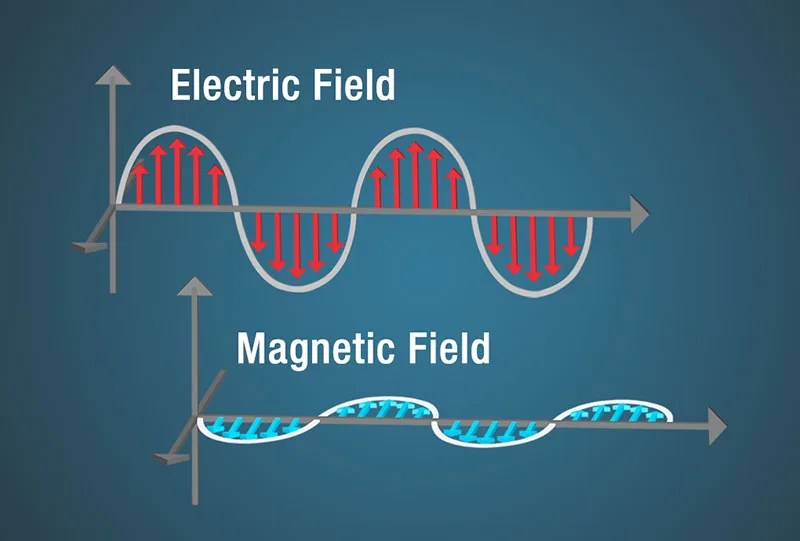
Heinrich Hertz, a German physicist, applied Maxwell's theories to the production and reception of radio waves. The unit of frequency of a radio wave -- one cycle per second -- is named the hertz, in honor of Heinrich Hertz.
His experiment with radio waves solved two problems. First, he had demonstrated in the concrete, what Maxwell had only theorized — that the velocity of radio waves was equal to the velocity of light! This proved that radio waves were a form of light! Second, Hertz found out how to make the electric and magnetic fields detach themselves from wires and go free as Maxwell's waves — electromagnetic waves.
WAVES OR PARTICLES? YES!
Light is made of discrete packets of energy called photons. Photons carry momentum, have no mass, and travel at the speed of light. All light has both particle-like and wave-like properties. How an instrument is designed to sense the light influences which of these properties are observed. An instrument that diffracts light into a spectrum for analysis is an example of observing the wave-like property of light. The particle-like nature of light is observed by detectors used in digital cameras—individual photons liberate electrons that are used for the detection and storage of the image data.
POLARIZATION
One of the physical properties of light is that it can be polarized. Polarization is a measurement of the electromagnetic field's alignment. In the figure above, the electric field (in red) is vertically polarized. Think of a throwing a Frisbee at a picket fence. In one orientation it will pass through, in another it will be rejected. This is similar to how sunglasses are able to eliminate glare by absorbing the polarized portion of the light.
DESCRIBING ELECTROMAGNETIC ENERGY
The terms light, electromagnetic waves, and radiation all refer to the same physical phenomenon: electromagnetic energy. This energy can be described by frequency, wavelength, or energy. All three are related mathematically such that if you know one, you can calculate the other two. Radio and microwaves are usually described in terms of frequency (Hertz), infrared and visible light in terms of wavelength (meters), and x-rays and gamma rays in terms of energy (electron volts). This is a scientific convention that allows the convenient use of units that have numbers that are neither too large nor too small.
The number of crests that pass a given point within one second is described as the frequency of the wave. One wave—or cycle—per second is called a Hertz (Hz), after Heinrich Hertz who established the existence of radio waves. A wave with two cycles that pass a point in one second has a frequency of 2 Hz.
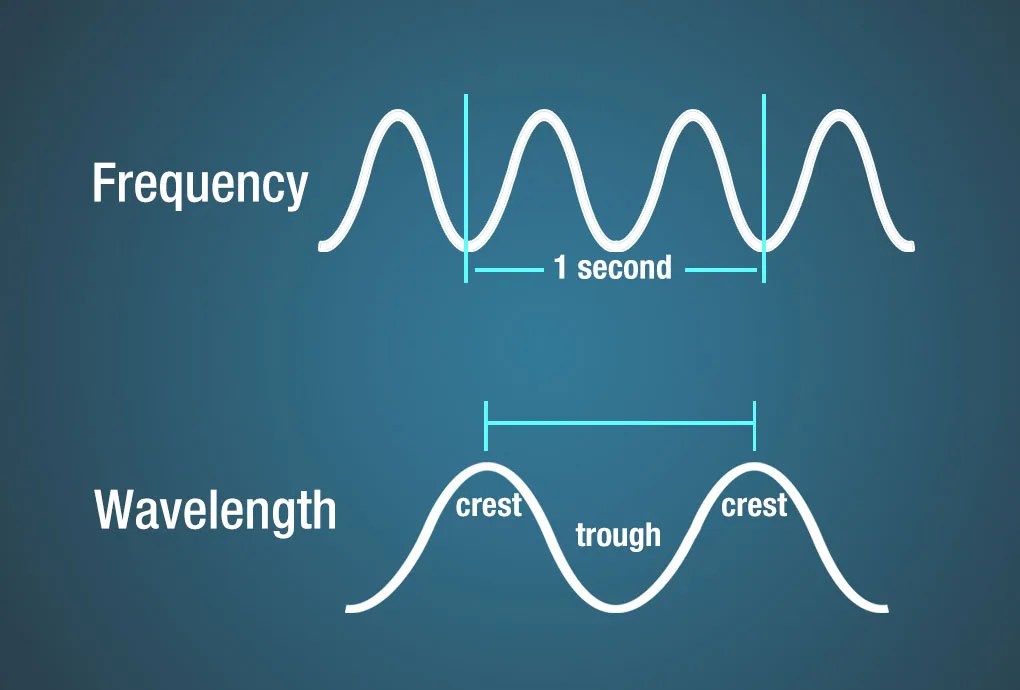
Electromagnetic waves have crests and troughs similar to those of ocean waves. The distance between crests is the wavelength. The shortest wavelengths are just fractions of the size of an atom, while the longest wavelengths scientists currently study can be larger than the diameter of our planet!
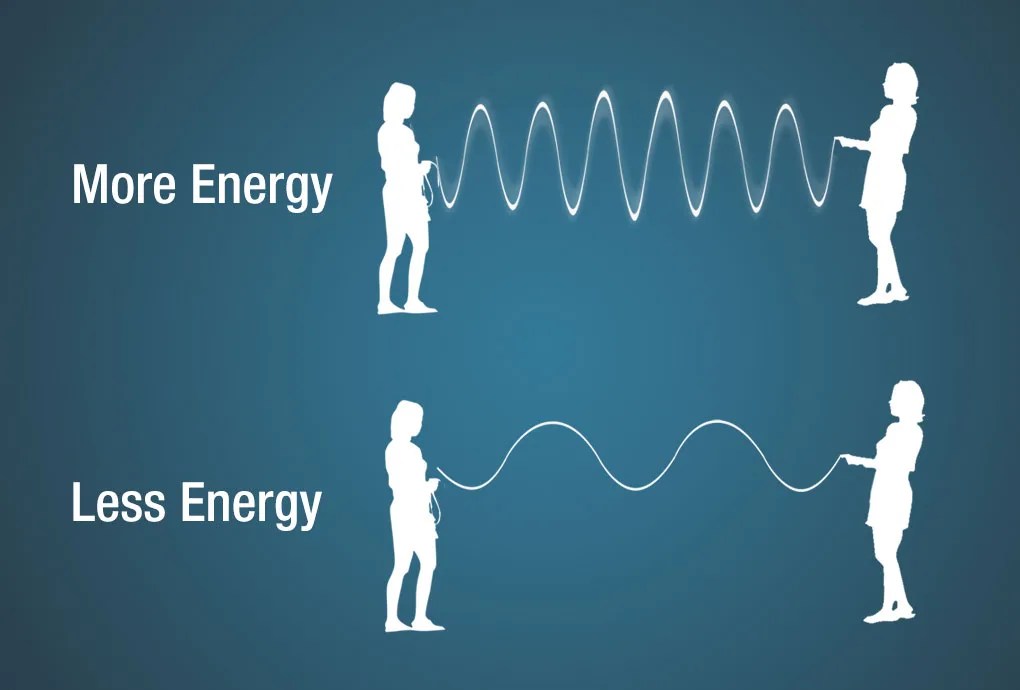
An electromagnetic wave can also be described in terms of its energy—in units of measure called electron volts (eV). An electron volt is the amount of kinetic energy needed to move an electron through one volt potential. Moving along the spectrum from long to short wavelengths, energy increases as the wavelength shortens. Consider a jump rope with its ends being pulled up and down. More energy is needed to make the rope have more waves.
Next: Wave Behaviors
National Aeronautics and Space Administration, Science Mission Directorate. (2010). Anatomy of an Electromagnetic Wave. Retrieved [insert date - e.g. August 10, 2016] , from NASA Science website: http://science.nasa.gov/ems/02_anatomy
Science Mission Directorate. "Anatomy of an Electromagnetic Wave" NASA Science . 2010. National Aeronautics and Space Administration. [insert date - e.g. 10 Aug. 2016] http://science.nasa.gov/ems/02_anatomy
Discover More Topics From NASA
James Webb Space Telescope

Perseverance Rover

Parker Solar Probe


- Q & A / Science
Why do radio waves travel at the speed of light and not sound?
by How It Works Team · 06/07/2013
Radio waves are a form of electromagnetic radiation – the same phenomenon as light, X-rays and various other types of radiation, but with much longer wavelengths. As such, they travel at the speed of light (ie 300,000 kilometres/186,000 miles per second) – a lot faster than the 340 metres (1,125 feet) per second that sound itself moves through the air. It’s easy to be fooled by the fact that when you hear the word ‘radio’, you usually think of voices or music, but radio waves aren’t sounds themselves – just the medium used to broadcast an electronic signal from the studio to your hi-fi, which the speaker then turns back into the vibrations in the air which we hear.
Answered by Giles Sparrow.
Enter our latest competition

Competition
Win a PC gaming bundle worth over £200!
- Next story How many metres does our blood travel every week?
- Previous story Fantasy inventions poll
Get the new issue

On sale now
Follow How It Works on twitter
Fast facts on instagram (@howitworksmag).

National Aeronautics and Space Administration
Goddard space flight center, imagine the universe, astronomer's toolbox.
- Cosmic Objects
- Big Questions
- Featured Science
- Observatories
- Scientist Profiles
- You Be the Astrophysicist
- The Cosmic Distance Scale
- Lesson Plans
- Ask an Astrophysicist
- Other Resources
- News #include virtual="/news/newsNav.html"
Additional Links
For Educators
Electromagnetic Spectrum
As it was explained in the Introductory Article on the Electromagnetic Spectrum , electromagnetic radiation can be described as a stream of photons , each traveling in a wave-like pattern, carrying energy and moving at the speed of light . In that section, it was pointed out that the only difference between radio waves, visible light and gamma rays is the energy of the photons. Radio waves have photons with the lowest energies. Microwaves have a little more energy than radio waves. Infrared has still more, followed by visible, ultraviolet , X-rays and gamma rays.
A video introduction to the electromagnetic spectrum. (Credit: NASA)
The amount of energy a photon has can cause it to behave more like a wave, or more like a particle. This is called the "wave-particle duality" of light . It is important to understand that we are not talking about a difference in what light is, but in how it behaves. Low energy photons (such as radio photons) behave more like waves, while higher energy photons (such as X-rays) behave more like particles.
The electromagnetic spectrum can be expressed in terms of energy, wavelength or frequency . Each way of thinking about the EM spectrum is related to the others in a precise mathematical way. Scientists represent wavelength and frequency by the Greek letters lambda (λ) and nu (ν). Using those symbols, the relationships between energy, wavelength and frequency can be written as wavelength equals the speed of light divided by the frequency, or
and energy equals Planck's constant times the frequency, or
- λ is the wavelength
- ν is the frequency
- E is the energy
- c is the speed of light, c = 299,792,458 m/s (186,212 miles/second)
- h is Planck's constant, h = 6.626 x 10 -27 erg-seconds

Conversion between wavelength, frequency and energy for the electromagnetic spectrum. (Credit: NASA's Imagine the Universe.)
Astronomy Across the Electromagnetic Spectrum
While all light across the electromagnetic spectrum is fundamentally the same thing, the way that astronomers observe light depends on the portion of the spectrum they wish to study.
For example, different detectors are sensitive to different wavelengths of light. In addition, not all light can get through the Earth's atmosphere , so for some wavelengths we have to use telescopes aboard satellites . Even the way we collect the light can change depending on the wavelength. Astronomers must have a number of different telescopes and detectors to study the light from celestial objects across the electromagnetic spectrum.
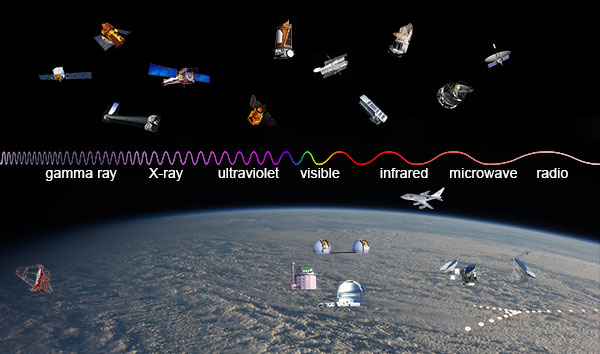
A sample of telescopes (operating as of February 2013) operating at wavelengths across the electromagnetic spectrum. Observatories are placed above or below the portion of the EM spectrum that their primary instrument(s) observe.
The represented observatories are: HESS, Fermi and Swift for gamma-ray, NuSTAR and Chandra for X-ray, GALEX for ultraviolet, Kepler, Hubble , Keck (I and II), SALT, and Gemini (South) for visible, Spitzer, Herschel, and Sofia for infrared, Planck and CARMA for microwave, Spektr-R, Greenbank, and VLA for radio. Click here to see this image with the observatories labeled.
(Credit: Credit: Observatory images from NASA, ESA (Herschel and Planck), Lavochkin Association (Specktr-R), HESS Collaboration (HESS), Salt Foundation (SALT), Rick Peterson/WMKO (Keck), Germini Observatory/AURA (Gemini), CARMA team (CARMA), and NRAO/AUI (Greenbank and VLA); background image from NASA)

- Project Leader: Dr. Barbara Mattson
- Web Curator: J.D. Myers
- Responsible NASA Official : Dr. Andy Ptak
- Privacy Policy & Important Notices
- Page Last Updated: 21-Jul-2017

Windupradio is supported by its audience. When you purchase via our links, we may get a commission. Learn more
How Fast Do Radio Waves Travel in Space (Explained with FAQs)

Writen by Edwin Jones

Fact checked by Andrew Wright
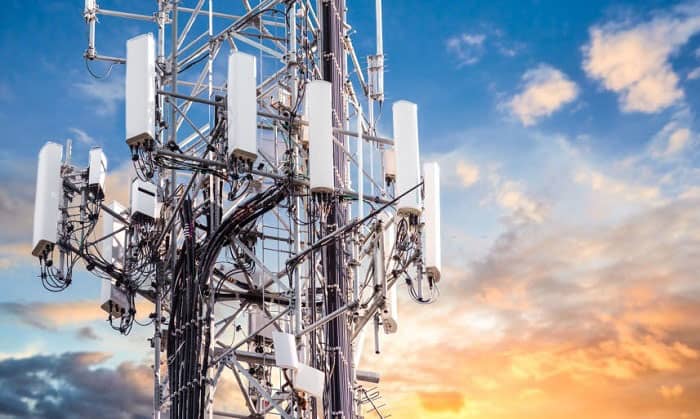
Radio waves play an essential role in most of the technological solutions around you. Unfortunately, very few people know about them; many people do not even know the meaning of radio waves. Therefore, there are a lot of misconceptions about radio waves and their velocity.
This article will provide everything you need to know about radio waves, including how fast do radio waves travel in space.
Table of Contents
What is the Speed of Radio Waves in Space?
What are radio waves, 1. low to medium frequencies, 2. higher frequencies, 3. shortwave radio, 4. highest frequencies, what are the properties of radio waves, 1. do radio waves continue in outer space, 2. does wi-fi take advantage of radio waves, 3. are radio waves the only type of electromagnetic wave, 4. what shape is a radio wave, 5. what are some practical applications of radio waves, 6. what electronics use radio waves, 7. are radio waves from a cell phone harmful.
Radio waves in space travel at the speed of light (c ≈299,79×10^6 m/s). That means the distance radio waves travel in 1 second in space is 299,792,458 meters (983,571,056 ft). So the speed of radio waves is much higher than that of sound waves .
Radio waves can travel through many different media at different speeds. When passing through a medium, the radio wave speed is decreased depending on the medium’s permittivity and permeability.
Radio waves have a wavelength of 0.04 inch to over sixty-two miles. As these waves go farther from the antenna that transmits them, their strength declines.
Contrary to what many people think, radio waves are not the sound you hear from your speakers or radio devices. What you hear are sound waves, not radio waves.
In essence, radio waves are electromagnetic radiation; therefore, they are pretty similar to a light wave . One difference between radio waves and light waves is that you cannot see radio waves.
Physicist James Clerk Maxwell foresaw the existence of radio waves; he created a famous Maxwell’s equation around the 1870s. Later, his prediction of radio waves was advanced by Heinrich Hertz, a German physicist. Heinrich Hertz was also the first to apply Maxwell’s equations to the transmission and reception of radio waves.
The unit of frequency for radio waves was named Hertz (Hz) in honor of Heinrich Hertz.
4 Main Types of Radio Waves
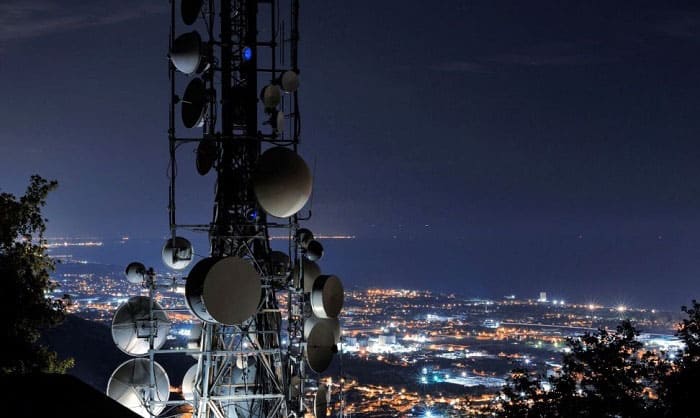
Radio waves are divided into several different types; these include:
These frequencies are the first kind in the radio frequency spectrum; this frequency range covers extremely low to medium radio waves.
ELF stands for extremely low frequency while VLF stands for very low frequency; They operate with frequencies from under 3 to 30 kHz. These frequencies are considered the lowest type of radio frequencies. Moreover, their long-range capability made them suitable for communications equipment in submarines.
In particular, they can penetrate water and rocks. Hence, they have been widely applied in caves and mines.
These frequencies are HF, VHF, and UHF. They are widely used in broadcast audio, public service radio, cell phones, FM, and GPS. As a rule, low frequencies travel farther and propagate better than higher frequencies.
Shortwave radio makes use of frequencies that range from 1.7 MHz to 30 MHz. They are applied in the transmission of radio signals from shortwave stations around the world.
For example, stations like the VOA, BBC, and Voice of Russia use this frequency range for broadcast purposes.
On the other hand, shortwave is also widely used for long-distance broadcast.
These are SHF (Super high frequency) and EHF (extremely high frequency). SHF is widely used in wireless USB, Wi-Fi, and Bluetooth; it is also utilized for radar purposes. In particular, super high frequencies can only operate on straight lines; that means they bounce off any obstacle.
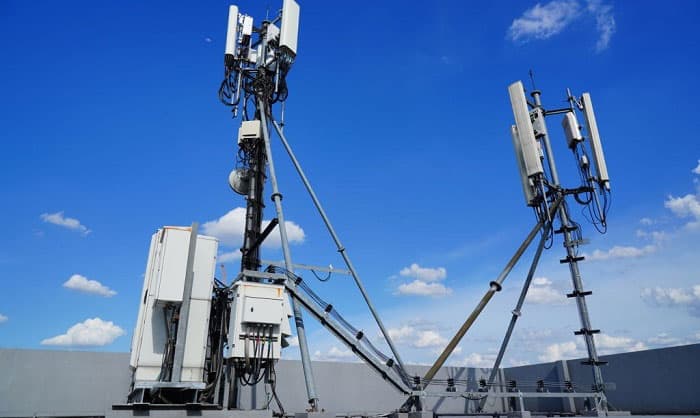
Radio waves come with some very different properties; these include:
- Their wavelength is longer than that of infrared light.
- Can overcome materials or obstacles.
- Can travel great distances.
- They cannot be seen and cannot be felt.
- Moving in a vacuum at the speed of light.
- They can be formed by electric currents (including lightning).
- Possess both electric and magnetic components.
- They can be absorbed, refracted, reflected, as well as polarized.
Frequently Asked Questions

Radio waves can be used to send messages to space. NASA actually uses them for communication.

Wi-Fi, like other wireless devices, applies radio frequencies to send signals between devices. However, the range of radio frequencies applied by Wifi is different from devices such as car radios, cell phones, weather radios, etc.
The short answer is no.
They are not the only components of the electromagnetic spectrum. There are several other forms of electromagnetic waves, including radar, BlueTooth, microwaves, infrared, ultraviolet light waves, and X-rays; all these components are electromagnetic waves.
Like other electromagnetic waves, radio waves look like ocean surface waves or any other type of wave. Wavelength is measured by the distance from the top of a peak to its neighboring peak.
Radio waves are used to transmit radio signals that your radio can pick up. In addition, they also work in carrying the signals you use for your smartphones and TVs.
There are devices that use radio waves for communication, such as two-way radios, television broadcasts, radio broadcasts, cellular telephones, cordless telephones, garage door openers, satellites, and countless other devices.
Some studies show that radio waves from cell phones can affect the metabolism of brain cells. However, there is no evidence that this effect is harmful.
Hopefully, after you finish reading this article, you will be confident enough to answer when someone asks you “how fast do radio waves travel in space” or “do radio waves travel at the speed of light?”
Thank you for reading. Please share this article if you find it helpful.

Hi, I am Amaro Frank – the Wind Up Radio’s content editor and writer. Working with Adam is so much fun, as his stories and experiences enrich my knowledge about radio communications and radio accessories. My main tasks in Wind Up Radio are building content and generating great articles on different topics around radio accessories.

- school Campus Bookshelves
- menu_book Bookshelves
- perm_media Learning Objects
- login Login
- how_to_reg Request Instructor Account
- hub Instructor Commons
- Download Page (PDF)
- Download Full Book (PDF)
- Periodic Table
- Physics Constants
- Scientific Calculator
- Reference & Cite
- Tools expand_more
- Readability
selected template will load here
This action is not available.

5.1.1: Speeds of Different Types of Waves
- Last updated
- Save as PDF
- Page ID 26167

- Kyle Forinash and Wolfgang Christian
The speed of a wave is fixed by the type of wave and the physical properties of the medium in which it travels. An exception is electromagnetic waves which can travel through a vacuum. For most substances the material will vibrate obeying a Hooke's law force as a wave passes through it and the speed will not depend on frequency. Electromagnetic waves in a vacuum and waves traveling though a linear medium are termed linear waves and have constant speed. Examples:
- For sound waves in a fluid (for example air or water) the speed is determined by \(v=(B/\rho )^{1/2}\) where \(B\) is the bulk modulus or compressibility of the fluid in newtons per meter squared and \(\rho\) is the density in kilograms per cubic meter.
- For sound waves in a solid the speed is determined by \(v= (Y/\rho )^{1/2}\) where \(Y\) is Young's modulus or stiffness in Newtons per meter squared and \(\rho\) is the density in kilograms per meter cubed.
- For waves on a string the speed is determined by \(v=(T/\mu )^{1/2}\) where \(T\) is the tension in the string in Newtons and \(\mu\) is the mass per length in kilograms per meter.
- Although electromagnetic waves do not need a medium to travel (they can travel through a vacuum) their speed in a vacuum, \(c = (1/\mu _{o} ε_{o})^{1/2} = 3.0\times 10^{8}\text{ m/s}\) is governed by two physical constants, the permeability \(\mu_{o}\) and the permittivity, \(ε_{o}\) of free space (vacuum).
Table \(\PageIndex{1}\)
Here is a more comprehensive list of the speed of sound in various materials .
As we saw in the previous chapter, there is a relationship between the period, wavelength and speed of the wave. The period of a cork floating in the water is affected by how fast the wave passes (wave speed) and the distance between peaks (wavelength). The relationship between speed, period and wavelength of a sine wave is given by \(v=\lambda /T\) where wavelength and period for a sine wave were defined previously. This can also be written as \(v=\lambda f\) since frequency is the inverse of period and is true for all linear waves. Notice that, since wave speed is normally a fixed quantity the frequency and wavelength will be inversely proportion; higher frequencies mean shorter wavelengths.
Often it is easier to write \(ω = 2πf\) where \(\omega\) is the angular frequency in radians per second instead of having to write \(2\pi f\) everywhere. Likewise it is easier to write \(k=2\pi /\lambda \) where \(k\) is the wave number in radians per meter rather than having to write \(2\pi /\lambda\) a lot. (Note that \(k\) is not a spring constant here.) Using these new definitions the speed of a wave can also be written as \(v=f\lambda =\omega /k\).
If the medium is uniform the speed of a wave is fixed and does not change. There are circumstances where the speed of a particular wave does change, however. Notice that the speed of sound in air depends on the density of the air (mass per volume). But the density of air changes with temperature and humidity. So the speed of sound can be different on different days and in different locations. The temperature dependence of the speed of sound in air is given by \(v = 344 + 0.6 (T - 20)\) in meters per second where \(T\) is the temperature in Celsius (\(T\) here is temperature, not period). Notice that at room temperature (\(20^{\circ}\text{C}\)) sound travels at \(344\text{ m/s}\).
The speed of sound can also be affected by the movement of the medium in which it travels. For example, wind can carry sound waves further (i.e. faster) if the sound is traveling in the same direction or it can slow the sound down if the sound is traveling in a direction opposite to the wind direction.
Electromagnetic waves travel at \(\text{c} = 3.0\times 10^{8}\text{ m/s}\) in a vacuum but slow down when they pass through a medium (for example light passing from air to glass). This occurs because the material has a different value for the permittivity and/or permeability due to the interaction of the wave with the atoms of the material. The amount the speed changes is given by the index of refraction \(n=c/v\) where \(c\) is the speed of light in a vacuum and \(v\) is the speed in the medium. The frequency of the wave does not change when it slows down so, since \(v=\lambda f\), the wavelength of electromagnetic waves in a medium must be slightly smaller.
Video/audio examples:
- What is the speed of sound in a vacuum? Buzzer in a bell jar . Why is there no sound when the air is removed from the jar?
- Demonstration of speed of sound in different gasses . Why is there no sound when the air is removed from the jar?
- These two videos demonstrate the Allasonic effect. The speed of sound is different in a liquid with air bubbles because the density is different. As the bubbles burst, the speed of sound changes, causing the frequency of sound waves in the liquid column to change, thus changing the pitch. Example: one , two . What do you hear in each case?
- The Zube Tube is a toy that has a spring inside attached to two plastic cups on either end. Vibrations in the spring travel at different speeds so a sound starting at one end (for example a click when you shake the tube and the spring hits the cup) ends up changing pitch at the other end as the various frequencies arrive. In other words this is a nonlinear system. See if you can figure out from the video which frequencies travel faster, high frequencies or low.
Mini-lab on measuring the speed of sound .
Questions on Wave Speed:
\(f=1/T,\quad v=f\lambda ,\quad v=\omega /k,\quad k=2\pi /\lambda,\quad \omega =2\pi f,\quad y(x,t)=A\cos (kx-\omega t+\phi ),\quad v=\sqrt{B/Q}\)
- Light travels at \(3.0\times 10^{8}\text{ m/s}\) but sound waves travel at about \(344\text{ m/s}\). What is the time delay for light and sound to arrive from a source that is \(10,000\text{ m}\) away (this can be used to get an approximate distance to a thunderstorm)?
- What two mistakes are made in science fiction movies where you see and hear an explosion in space at the same time?
- Consult the table for the speed of sound in various substances. If you have one ear in the water and one ear out while swimming in a lake and a bell is rung that is half way in the water some distance away, which ear hears the sound first?
- At \(20\text{C}\) the speed of sound is \(344\text{ m/s}\). How far does sound travel in \(1\text{ s}\)? How far does sound travel in \(60\text{ s}\)?
- Compare the last two answers with the distance traveled by light which has a speed of \(3.0\times 10^{8}\text{ m/s}\). Why do you see something happen before you hear it?
- The speed of sound in water is \(1482\text{ m/s}\). How far does sound travel under water in \(1\text{ s}\)? How far does sound travel under water in \(60\text{ s}\)?
- What happens to the speed of sound in air as temperature increases?
- Using the equation for the speed of sound at different temperatures, what is the speed of sound on a hot day when the temperature is \(30^{\circ}\text{C}\)? Hint: \(v = 344\text{ m/s} + 0.6 (T - 20)\) where \(T\) is the temperature in Celsius.
- Using the speed of sound at \(30^{\circ}\text{C}\) from the last question, recalculate the distance traveled for the cases in question four.
- Suppose on a cold day the temperature is \(-10^{\circ}\text{C}\: (14^{\circ}\text{F}\)). You are playing in the marching band outside. How long does it take the sound from the band to reach the spectators if they are \(100\text{ m}\) away?
- What is the difference in the speed of sound in air on a hot day (\(40^{\circ}\text{C}\)) and a cold day (\(0^{\circ}\text{C}\))?
- What would an orchestra sound like if different instruments produced sounds that traveled at different speeds?
- The speed of a wave is fixed by the medium it travels in so, for a given situation, is usually constant. What happens to the frequency of a wave if the wavelength is doubled?
- What happens to the wavelength of a wave if the frequency is doubled and has the same speed?
- Suppose a sound wave has a frequency \(200\text{ Hz}\). If the speed of sound is \(343\text{ m/s}\), what wavelength is this wave?
- What factors determine the speed of sound in air?
- Why do sound waves travel faster through liquids than air?
- Why do sound waves travel faster through solids than liquids?
- The speed of sound in a fluid is given by \(v=\sqrt{B/Q}\) where \(B\) is the Bulk Modulus (compressibility) and \(Q\) is the density. What happens to the speed if the density of the fluid increases?
- What must be true about the compressibility, \(B\), of water versus air, given that sound travels faster in water and water is denser than air?
- The speed of sound in a fluid is given by \(v=\sqrt{B/Q}\) where \(B\) is the Bulk Modulus (compressibility) and \(Q\) is the density. Can you think of a clever way to measure the Bulk Modulus of a fluid if you had an easy way to measure the speed of sound in a fluid? Explain.
- The speed of sound on a string is given by \(v=\sqrt{T/\mu}\) where \(T\) is the tension in Newtons and \(\mu\) is the linear density (thickness) in \(\text{kg/m}\). You also know that \(v=f\lambda\). Give two ways of changing the frequency of vibration of a guitar string based on the knowledge of these two equations.
- For the previous question, increasing the tension does what to the frequency? What does using a denser string do to the frequency?
- The following graph is of a wave, frozen in time at \(t = 0\). The equation describing the wave is \(y(x,t)=A\cos (kx-\omega t+\phi )\). Sketch the effect of doubling the amplitude, \(A\).
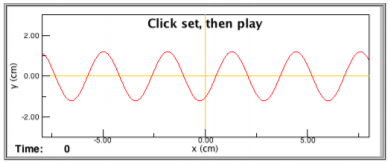
Figure \(\PageIndex{1}\)
- For the following graph of a wave, sketch the effect of doubling the wavelength.
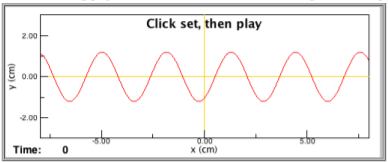
Figure \(\PageIndex{2}\)
- The mathematical description of a sine wave is given by \(y(x,t)=A\cos (kx-\omega t+\phi )\). Explain what each of the terms \((A, k, \omega, \phi )\) represent.

How Fast Do Radio Waves Travel In A Vacuum-Air-Space
Last Updated: February 1, 2024
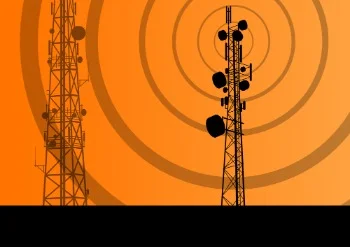
The effective use of radio waves in communication technologies today is based on how fast radio waves travel.
Radio waves play a significant role in most of the technology solutions we see around us.
But, as common as they are, very little is known about them. For most people, they don’t even know the meaning of radio waves.
There is a lot of misconception out there regarding radio waves. From what they are to how they function, only a handful of people know anything about this wave type.
As a result, this post will be breaking down everything you need to know about radio waves.
By the time you are done reading this, you should be confident enough to tell someone else exactly what radio waves are and how they function.
What are radio waves?
Unlike what many people think, radio waves are not the sounds you hear coming out of your radio speakers. That is sound waves, not radio waves.
Radio waves are electromagnetic radiation. Radio waves are quite similar to light waves. The only difference is that you cannot see them as light.
Think of them as being produced by charged particles going through acceleration, like in time-changing electric currents.
Transmitters artificially generate them. You need a radio receiver to intercept and receive the radio waves with the help of an antenna.
The application of radio waves is used in many technologies.
They are employed in mobile and fixed radio communication, radar & navigation systems, broadcasting, wireless computer network, communication satellites, and a host of others.
Radio waves were discovered by James Clerk Maxwell, the physicist who was known for the famous Maxwell’s Equation around the 1870s.
A German physicist known as Heinrich Hertz was the one who advanced Maxwell’s prediction of radio waves.
He was the first to apply Maxwell’s equation to the transmission and reception of radio waves.
The unit of frequency for EM waves was unanimously agreed to be Hertz by the American Association For The Advancement of Science, in honor of Heinrich Hertz.
Properties of radio waves
Radio waves have got some highly distinct properties that you ought to be aware of. Those properties will be outlined below
- They are a form of electromagnetic waves. They have got a wavelength longer than the wavelength of infrared light.
- Radio waves can go through materials or obstacles.
- They can travel extremely long distances.
- Radio waves are invisible and cannot be felt either.
- When they move through a vacuum, they do so at the speed of light. But, their speed drops when they move through a medium, depending on the medium’s permeability.
- Radio waves have a wavelength range between thousands of meters and 30cm.
- Radio waves can be formed as a result of changing electric currents. Naturally, they can be emitted by lightning and astronomical objects that can exhibit magnetic field changes.
- Radio waves possess both magnetic and electric components
- They can experience absorption, refraction, reflection, as well as polarization.

Types of Radio Wave
Radio waves are subdivided into various categories. This section of this post will be discussing the different radio waves, as seen below.
Low to medium frequencies
This frequency range is the first category in the radio frequency spectrum. It is composed of extremely low to medium radio waves.
ELF and VLF stand for extremely low frequency and very low frequency, respectively. This class of radio waves operates with a frequency of between 0.1 and 30 kHz.
They are classified as the lowest radio frequencies. They’ve got long-range capabilities that make them suitable for communication items in submarines.
That is because they can penetrate water and rocks. They have also found useful applications in caves and mines.
Higher frequencies
HF, VHF, and UHF bands comprise public service radio, broadcast television sound, cellphones, FM, and GPS.
These bands employ FM or frequency modulation to impress or encode a data or audio signal upon the carrier wave.
In FM, the signal’s amplitude is kept constant, while the frequency is varied along with the magnitude and rate that corresponds to the data or audio signal.
That is why the signal quality of FM is better than that of AM. Environmental factors do not have a similar influence on frequency as they do on amplitude.
Furthermore, the FM receivers are built to ignore any amplitude variations so long as the signal maintains the least threshold value.
Shortwave radio
Shortwave radio makes use of frequencies between 1.7 kHz and 30 MHz.
This frequency range is what is used to transmit radio signals from shortwave stations across the globe.
Stations like the BBC, VOA, Voice of Russia, and hundreds of other stations use this frequency range for broadcast purposes.
Shortwaves are preferred for long-distance broadcast due to their signals’ ability to reflect on the ionosphere and rebound back far away from where the signal has been broadcast.
Highest frequencies
Super high frequency (SHF) and extremely high frequency (EHF) are considered among the microwave band of the radio-frequency spectrum.
With the help of this frequency range, high-bandwidth, short-range communications can happen between fixed locations.
SHF is used in applications such as Wi-Fi, wireless USB, and Bluetooth. They are also employed for radar purposes because they possess the ability to bounce off obstacles.
It is noteworthy that SHF can only function in straight paths. They bounce off any obstacle they come in contact with.
How Fast Do Radio Waves Travel? Through Space, Air or Vacuum
How fast do radio waves travel has been answered so many times, yet some people are still confused about the subject.
Earlier, we were able to establish that radio waves are electromagnetic. That means they are going to behave like electromagnetic waves too.
One thing that is common to all electromagnetic waves is that they all travel at the speed of light in a vacuum. They travel at an approximate speed of 186,000 miles per second in a vacuum.
Unlike radio waves, sound waves cannot travel through a vacuum. They can only travel through a medium.
In other words, without a medium, you cannot have sound. Radio waves do not necessarily need any medium for their propagation.
Radio waves travel at the same speed as light because they are like light waves, except that they are unseen.
Radio waves can equally travel through various mediums at different speeds. How fast they are going to travel through a specific medium will be determined by some factors.
Some of those factors include the permittivity and permeability of the medium in question.
Radio waves are much faster than sound waves, even if you have to pass them through the same medium for the sake of comparison.
How do radio waves work?
The best way to answer how do radio waves work is by using antennas to explain the concept.
For radio waves to be effectively broadcast and received, we will need two antennas. One will be the transmitter, while the other will be the receiver.
Let’s use a radio station as an example. At the radio station, voice can be captured by a mic, where the system will convert it into a form of electrical energy.
That electricity is then sent through an antenna (transmitter) with great height. The transmitter will boost the power of the electricity so it can travel as far as possible.
The tiny particles within the electric current continuously move back and forth within the antenna, and radio waves are automatically produced.
The radio waves then travel at the speed of light or close to that value, with the voices trapped within them.
Therefore, when someone puts on their radio set, the electrons in their antenna are made to move back and forth (vibrated) by the incoming radio waves.
That resonating action brings about an electric current. The electronics component then converts that electric signal to sound, allowing you to hear the voice recorded at the station.
Why do radio waves travel at the speed of light and not sound?
Sound waves need a medium before they can travel between locations.
For example, let’s take the air; sound waves can travel through the air because it is composed of molecules.
Without any molecules in the air, it will be impossible to transmit sound waves across the atmosphere. That is where radio waves differ from sound waves.
Radio waves travel at the speed of light because both light and radio waves belong to electromagnetic waves.
Sound waves do not belong to this class. Instead, they are grouped in the class of mechanical waves.
All electromagnetic waves can travel through a vacuum at the speed of light. So that is the simple reason radio waves tend to travel at the speed of light and not sound waves.
FAQs Regarding The Speed of Radio Waves
Do all the different types of radio waves travel at the same speed.
The radio frequency spectrum is a composition of the different types of radio waves.
But because the radio waves are a part of an electromagnetic spectrum, they will all travel at the same speed across a vacuum.
That speed is the speed of light. Having said that, if they are to travel across different mediums, then their speeds will vary.
Do radio waves continue in outer space?
Yes, radio waves continue indefinitely until they come in contact with something.
But, even before that happens, they usually become weak and blend with the universe’s background noise.
That means the first set of radio waves emitted into outer space must be over a hundred light-years old by now.
What is the speed of red light in a vacuum?
Light travels through a vacuum at a constant speed. The speed at which light travels through a vacuum has nothing to do with its polarization, frequency, or other light wave characteristics.
In other words, the color of the wave does not affect its speed in a vacuum. Whether it is blue or red light, it will travel at an approximate speed of 300,000 km per second.
Does Wi-Fi make use of radio waves?
Just like other wireless devices, Wi-Fi implements radio frequencies for sending signals between devices.
The range of radio frequencies employed by Wi-Fi is quite different from devices like cell phones, car radios, weather radios, or walky-talkies.
For instance, your car radio receives frequencies in the range of between Kilohertz and Megahertz, suitable for AM and FM stations, respectively.
Wi-Fi, on the other hand, implements its data transmission in the region of Gigahertz. So, in general, you can say that Wi-Fi uses radio waves for transmitting data between devices.
What are some of the uses of radio waves?
Radio waves possess the longest wavelengths in the EM spectrum. Radio waves aren’t just used for transmitting radio signals that your radio can pick up.
They are actively responsible for carrying the signals you use for your cell phones and TV.
The moment your TV antenna picks up an incoming signal from a TV station, it does that in the form of radio waves or EM waves.
Are radio waves the only type of electromagnetic wave?
The answer to this question is No! Radio waves are not the only component of the electromagnetic spectrum.
Other forms of electromagnetic waves include Bluetooth, radar, microwaves, ultraviolet light waves, infra-red, and X-rays.
So it is right for you to assume all these components as electromagnetic waves.
Waves are generally classified into two groups – mechanical waves and electromagnetic waves.
Radio waves belong to the group of the latter. That explains the reason behind their ability to travel through a vacuum.
In stark contrast, sound waves are unable to travel through a vacuum due to their mechanical properties.
Sound waves require a medium for them to be propagated from one point to another.
Radio waves, just like other electromagnetic waves, travel through a vacuum at the speed of light.
Radio waves are employed in a wide range of technology applications. They make up the very core of communication technology.
Similar Posts:
- How Does A Radio Wave Differ From A Sound Wave?
- What is Radio Frequencies? Types of Radio Frequencies
- Micropower Broadcasting: A Technical Primer (How to Start a Micro-Radio Station)
- Top 14 Best Long Range Omnidirectional TV Antennas in 2024 (Reviews & Buying Guide)
- 11 Best Marine TV Antenna Reviews in 2024 – Buying Guide
Leave a Comment Cancel reply
Save my name and email in this browser for the next time I comment.
Radio4All.org is a participant in the Amazon Services LLC Associates Program, an affiliate advertising program designed to provide a means for sites to earn advertising fees by advertising and linking to Amazon.com. As an Amazon Associate I earn from qualifying purchases.
© Radio4All.org
Wavelength Calculator
Table of contents
The wavelength calculator can assist you in determining the relationship between frequency and wavelength. Continue reading if you are here to learn how to calculate the frequency of a wave or look for the wavelength formula.
Main properties of waves
There are three main properties of a wave: its velocity, wavelength, and frequency.
Wave velocity (v) is how fast a wave propagates in a given medium. Its unit is meter per second. Check the speed calculator for more information about speed and velocity.
Wavelength (λ) is the distance over which the shape of a wave repeats. It depends on the medium in which a wave travels. It is measured in meters.
Frequency (f) of a wave refers to how many times (per a given time duration) the particles of a medium vibrate when the wave passes through it. The unit of frequency is Hertz or 1/second.
Wavelength formula
The relationship between wavelength and frequency is described by this simple equation:
Remember about the proper units! If in trouble, you can always use the speed conversion .
How to calculate wavelength
It's easy! Just use our wavelength calculator in the following way:
- Determine the frequency of the wave. For example, f = 10 MHz . This frequency belongs to the radio waves spectrum.
- Choose the velocity of the wave. As a default, our calculator uses a value of 299,792,458 m/s - the speed of light propagating in a vacuum.
- Substitute these values into the wavelength equation λ = v/f .
- Calculate the result. In this example, the wavelength will be equal to 29.98 m .
- You can also use this tool as a frequency calculator. Simply type in the values of velocity and wavelength to obtain the result.
Remember that the frequency doesn't change when passing from one medium to another. If you are trying to solve a complex problem with more than one medium, use the wavelength formula again with the same frequency, but different velocity.
Waves with similar wavelengths produce easily recognizable beats. Here's our tool with which you can calculate the beat frequency . And we can also quantify the performance of our waves or signals using our modulation calculator .
Typical wave speeds
You can find a few typical wave velocity values below. Type them into our wavelength calculator to learn what is, for example, the wavelength of red light in water.
- Light in air or vacuum: 299,792,458 m/s
- Light in water: 224,901,000 m/s
- Sound in air: 343.2 m/s
- Sound in water (20 °C): 1,481 m/s
How does light wavelength affect photosynthesis?
The best wavelengths of light for photosynthesis are those that are blue (375-460 nm) and red (550-700 nm) . These wavelengths are absorbed as they have the right amount of energy to excite electrons in the plant's pigments , the first step in photosynthesis. This is why plants appear green because red and blue light that hits them is absorbed!
What is the relationship between frequency and wavelength?
Frequency (f) and wavelength (λ) are joined by the equation fλ = c , where c is the speed of light. As the speed of light is constant, if you increase the frequency, the wavelength must decrease to maintain this equation and vice versa. This means that the relationship between frequency and wavelength is inversely proportional .
What color is the longest wavelength?
The color of the longest wavelength that we can see is red, with a wavelength of ~700 nm . The wave with the longest wavelength, radio waves , cannot be seen by the human eye, and therefore doesn't have a color . The color of the shortest wavelength is violet, at about 400 nm.
How do you measure wavelength?
To measure a wavelength:
- Use a photometer to measure the energy of a wave.
- Convert the energy into joules (J).
- Divide the energy by Planck’s constant , 6.626 × 10⁻³⁴ J⋅Hz⁻¹, to get the frequency of the wave.
- Divide the speed of light, ~300,000,000 m/s, by the frequency to get wavelength.
What is wavelength measured in?
Wavelength is the distance between two peaks (or troughs) of a wave, and is therefore measured in meters . Due to waves coming in all shapes and sizes, the prefix associated with meters can change dramatically, from km for radio waves, micrometers for visible light (although often given in nanometers), to picometers for gamma rays.
How do you calculate energy from wavelength?
To estimate the energy:
- Convert your wavelength into meters.
- Divide the speed of light, ~300,000,000 m/s, by the wavelength in m. This gives you the wave's frequency.
- Multiply the frequency by Planck’s constant , 6.626 × 10⁻³⁴ J⋅Hz⁻¹. The result is the waves energy in joules (J).
How do you calculate wavelength from wavenumber?
To evaluate the wavelength:
- Take your wavenumber, noting the units.
- Divide 1 by the wavenumber .
- It’s as easy as that!
- The units for your new wavelength are 1 over the old units, so 1/cm becomes cm.
Preset wave velocity
Choose the Custom option at the end of the dropdown to enter a custom wave velocity.
Wave velocity
Wave frequency
Wavelength (λ)
Claudia Looi
Touring the Top 10 Moscow Metro Stations
By Claudia Looi 2 Comments

Komsomolskaya metro station looks like a museum. It has vaulted ceilings and baroque decor.
Hidden underground, in the heart of Moscow, are historical and architectural treasures of Russia. These are Soviet-era creations – the metro stations of Moscow.
Our guide Maria introduced these elaborate metro stations as “the palaces for the people.” Built between 1937 and 1955, each station holds its own history and stories. Stalin had the idea of building beautiful underground spaces that the masses could enjoy. They would look like museums, art centers, concert halls, palaces and churches. Each would have a different theme. None would be alike.
The two-hour private tour was with a former Intourist tour guide named Maria. Maria lived in Moscow all her life and through the communist era of 60s to 90s. She has been a tour guide for more than 30 years. Being in her 60s, she moved rather quickly for her age. We traveled and crammed with Maria and other Muscovites on the metro to visit 10 different metro stations.

Arrow showing the direction of metro line 1 and 2

Moscow subways are very clean
To Maria, every street, metro and building told a story. I couldn’t keep up with her stories. I don’t remember most of what she said because I was just thrilled being in Moscow. Added to that, she spilled out so many Russian words and names, which to one who can’t read Cyrillic, sounded so foreign and could be easily forgotten.
The metro tour was the first part of our all day tour of Moscow with Maria. Here are the stations we visited:
1. Komsomolskaya Metro Station is the most beautiful of them all. Painted yellow and decorated with chandeliers, gold leaves and semi precious stones, the station looks like a stately museum. And possibly decorated like a palace. I saw Komsomolskaya first, before the rest of the stations upon arrival in Moscow by train from St. Petersburg.
2. Revolution Square Metro Station (Ploshchad Revolyutsii) has marble arches and 72 bronze sculptures designed by Alexey Dushkin. The marble arches are flanked by the bronze sculptures. If you look closely you will see passersby touching the bronze dog's nose. Legend has it that good luck comes to those who touch the dog's nose.

Touch the dog's nose for good luck. At the Revolution Square station

Revolution Square Metro Station
3. Arbatskaya Metro Station served as a shelter during the Soviet-era. It is one of the largest and the deepest metro stations in Moscow.

Arbatskaya Metro Station
4. Biblioteka Imeni Lenina Metro Station was built in 1935 and named after the Russian State Library. It is located near the library and has a big mosaic portrait of Lenin and yellow ceramic tiles on the track walls.

Lenin's portrait at the Biblioteka Imeni Lenina Metro Station

5. Kievskaya Metro Station was one of the first to be completed in Moscow. Named after the capital city of Ukraine by Kiev-born, Nikita Khruschev, Stalin's successor.

Kievskaya Metro Station
6. Novoslobodskaya Metro Station was built in 1952. It has 32 stained glass murals with brass borders.

Novoslobodskaya metro station
7. Kurskaya Metro Station was one of the first few to be built in Moscow in 1938. It has ceiling panels and artwork showing Soviet leadership, Soviet lifestyle and political power. It has a dome with patriotic slogans decorated with red stars representing the Soviet's World War II Hall of Fame. Kurskaya Metro Station is a must-visit station in Moscow.

Ceiling panel and artworks at Kurskaya Metro Station

8. Mayakovskaya Metro Station built in 1938. It was named after Russian poet Vladmir Mayakovsky. This is one of the most beautiful metro stations in the world with 34 mosaics painted by Alexander Deyneka.

Mayakovskaya station

One of the over 30 ceiling mosaics in Mayakovskaya metro station
9. Belorusskaya Metro Station is named after the people of Belarus. In the picture below, there are statues of 3 members of the Partisan Resistance in Belarus during World War II. The statues were sculpted by Sergei Orlov, S. Rabinovich and I. Slonim.

10. Teatralnaya Metro Station (Theatre Metro Station) is located near the Bolshoi Theatre.

Teatralnaya Metro Station decorated with porcelain figures .

Taking the metro's escalator at the end of the tour with Maria the tour guide.
Have you visited the Moscow Metro? Leave your comment below.
January 15, 2017 at 8:17 am
An excellent read! Thanks for much for sharing the Russian metro system with us. We're heading to Moscow in April and exploring the metro stations were on our list and after reading your post, I'm even more excited to go visit them. Thanks again 🙂
December 6, 2017 at 10:45 pm
Hi, do you remember which tour company you contacted for this tour?
Leave a Reply Cancel reply
You must be logged in to post a comment.
Please go to the Instagram Feed settings page to create a feed.

IMAGES
VIDEO
COMMENTS
Air is thin enough that in the Earth's atmosphere radio waves travel very close to the speed of light. The wavelength is the distance from one peak (crest) of the wave's electric field to the next, and is inversely proportional to the frequency of the wave. The relation of frequency and wavelength in a radio wave traveling in vacuum or air is.
Radio waves travel at the speed of light, even in space. Learn how long it takes for radio waves to reach Pluto, the moon, the sun and other objects in the solar system and beyond. Compare radio waves with other types of waves and see if we can detect radio waves from aliens.
Radio propagation is the behavior of radio waves as they travel, or are propagated, from one point to another in vacuum, or into various parts of the atmosphere. [1] : 26‑1 As a form of electromagnetic radiation, like light waves, radio waves are affected by the phenomena of reflection, refraction, diffraction, absorption, polarization, and ...
Radio waves have the longest wavelengths in the electromagnetic spectrum. They range from the length of a football to larger than our planet. Heinrich Hertz proved the existence of radio waves in the late 1880s. He used a spark gap attached to an induction coil and a separate spark gap on a receiving antenna. When waves created by the sparks of ...
Like all waves of the electromagnetic spectrum, radio waves travel at the speed of light. The speed of light in a vacuum is 299,792,458 meters per second, often approximated simply as 3 x 108 m/s. It is usually denoted by the symbol c, for the Latin celeritas, meaning "swiftness." Here on Earth, when you turn on the light switch the light ...
The period of the wave is measured at T = 3.3 ns (the oscillator was set at 300 MHz), so the speed is λ/T = 3.0 X 10 8 m.s −1. ( Thanks to Barry Perczuk, Pat McMillan and the UNSW third year physics lab for lending both the UHF oscillator and the 500 MHz oscilloscope. It's interesting to compare this measured speed of radio waves with the ...
Actually, radio waves travel very quickly through space. Radio waves are a kind of electromagnetic radiation, and thus they move at the speed of light. The speed of light is a little less than 300,000 km per second. At that speed, a beam of light could go around the Earth at the equator more then 7 times in a second. The reason that it takes so ...
This proved that radio waves were a form of light! Second, Hertz found out how to make the electric and magnetic fields detach themselves from wires and go free as Maxwell's waves — electromagnetic waves. ... Photons carry momentum, have no mass, and travel at the speed of light. All light has both particle-like and wave-like properties. How ...
So the speed of light, which is 3 followed by 8 zeroes, becomes. 3 x 108 meters per second. The standard symbol for the speed of light is c, so we can write: c = 3 x 108 m/s. Since radio waves travel at a constant speed, the distance traveled is given by: or. where distance = speed times time. d = c t. d = distance in meters.
1. Find the wavelength of a radio wave with a frequency of 650 kHz. 4.6 x 102 m (460 m) 2. Find the wavelength of a radio wave with a frequency of 1300 kHz. 2.3 x 102 m (230 m) 3. Find the wavelength of a radio wave with a frequency of 90 MHz. 3.3 m 4. Find the wavelength of a radio wave with a frequency of 101.5 MHz. 2.96 m 5.
Radio waves are a form of electromagnetic radiation - the same phenomenon as light, X-rays and various other types of radiation, but with much longer wavelengths. As such, they travel at the speed of light (ie 300,000 kilometres/186,000 miles per second) - a lot faster than the 340 metres (1,125 feet) per second that sound itself moves ...
Advanced; Basic; The Electromagnetic Spectrum. As it was explained in the Introductory Article on the Electromagnetic Spectrum, electromagnetic radiation can be described as a stream of photons, each traveling in a wave-like pattern, carrying energy and moving at the speed of light.In that section, it was pointed out that the only difference between radio waves, visible light and gamma rays is ...
A radio wave is an electromagnetic wave ( EM wave ). EM waves are of different categories depending upon their wavelengths and the one with the longest wavelength is the radio waves. Unlike sound waves which is a mechanical wave which require an elastic medium to travel, electromagnetic waves consist of synchronized oscillations of electric and ...
Radio waves in space travel at the speed of light (c ≈299,79×10^6 m/s). That means the distance radio waves travel in 1 second in space is 299,792,458 meters (983,571,056 ft). So the speed of radio waves is much higher than that of sound waves. Radio waves can travel through many different media at different speeds.
For sound waves in a fluid (for example air or water) the speed is determined by v = (B/ρ)1/2 where B is the bulk modulus or compressibility of the fluid in newtons per meter squared and ρ is the density in kilograms per cubic meter. For sound waves in a solid the speed is determined by v = (Y/ρ)1/2 where Y is Young's modulus or stiffness in ...
Einstein predicted that particles and information can't travel faster than the speed of light, but phenomena like radio waves are a different story, said John Singleton, who works at the Los ...
They travel at an approximate speed of 186,000 miles per second in a vacuum. Unlike radio waves, sound waves cannot travel through a vacuum. They can only travel through a medium. In other words, without a medium, you cannot have sound. Radio waves do not necessarily need any medium for their propagation.
Determine the frequency of the wave. For example, f = 10 MHz. This frequency belongs to the radio waves spectrum. Choose the velocity of the wave. As a default, our calculator uses a value of 299,792,458 m/s - the speed of light propagating in a vacuum. Substitute these values into the wavelength equation λ = v/f. Calculate the result.
3. How fast do radio waves travel to the moon? The speed of radio waves in meters per second is approximately 300,000,000. The average distance between Earth and the Moon is 384,400,000 meters. Thus, it takes only over a second for radio waves to travel the distance. But the time can be longer than expected (from 2.4 to 2.7 seconds) due to echo ...
Revolution Square Metro Station. 3. Arbatskaya Metro Station served as a shelter during the Soviet-era. It is one of the largest and the deepest metro stations in Moscow. Arbatskaya Metro Station. 4. Biblioteka Imeni Lenina Metro Station was built in 1935 and named after the Russian State Library.
The 9th radio center in Elektrostal is home to a high power medium wave transmitter. ... LiAZ-5256 bus. Elektrostal is linked by Elektrichka suburban electric trains to Moscow's Kursky Rail Terminal with a travel time of 1 hour and 20 minutes. Long distance buses link Elektrostal to Noginsk, ...
The 9th radio centre of Moscow was a high power shortwave and medium wave broadcasting facility at Elektrostal near Moscow. Its broadcasting frequency was 873 kHz with a transmission power of up to 1200 kilowatts. It was also used as radio jammer of "unwanted" stations. ()
Drive • 50 min. Drive from Moscow Central Bus Station to Elektrostal 48.9 km. RUB 370 - RUB 550. Quickest way to get there Cheapest option Distance between.